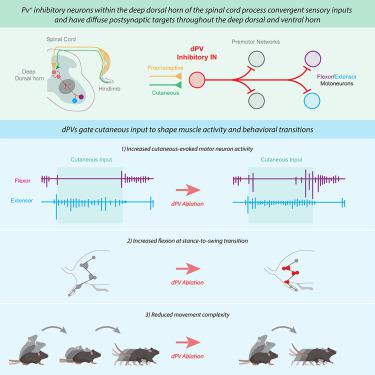Our official English website, www.x-mol.net, welcomes your feedback! (Note: you will need to create a separate account there.)
Multimodal sensory control of motor performance by glycinergic interneurons of the mouse spinal cord deep dorsal horn
Neuron ( IF 16.2 ) Pub Date : 2024-03-06 , DOI: 10.1016/j.neuron.2024.01.027 Mark A. Gradwell , Nofar Ozeri-Engelhard , Jaclyn T. Eisdorfer , Olivier D. Laflamme , Melissa Gonzalez , Aman Upadhyay , Laura Medlock , Tara Shrier , Komal R. Patel , Adin Aoki , Melissa Gandhi , Gloria Abbas-Zadeh , Olisemaka Oputa , Joshua K. Thackray , Matthew Ricci , Arlene George , Nusrath Yusuf , Jessica Keating , Zarghona Imtiaz , Simona A. Alomary , Manon Bohic , Michael Haas , Yurdiana Hernandez , Steven A. Prescott , Turgay Akay , Victoria E. Abraira
Neuron ( IF 16.2 ) Pub Date : 2024-03-06 , DOI: 10.1016/j.neuron.2024.01.027 Mark A. Gradwell , Nofar Ozeri-Engelhard , Jaclyn T. Eisdorfer , Olivier D. Laflamme , Melissa Gonzalez , Aman Upadhyay , Laura Medlock , Tara Shrier , Komal R. Patel , Adin Aoki , Melissa Gandhi , Gloria Abbas-Zadeh , Olisemaka Oputa , Joshua K. Thackray , Matthew Ricci , Arlene George , Nusrath Yusuf , Jessica Keating , Zarghona Imtiaz , Simona A. Alomary , Manon Bohic , Michael Haas , Yurdiana Hernandez , Steven A. Prescott , Turgay Akay , Victoria E. Abraira

|
Sensory feedback is integral for contextually appropriate motor output, yet the neural circuits responsible remain elusive. Here, we pinpoint the medial deep dorsal horn of the mouse spinal cord as a convergence point for proprioceptive and cutaneous input. Within this region, we identify a population of tonically active glycinergic inhibitory neurons expressing parvalbumin. Using anatomy and electrophysiology, we demonstrate that deep dorsal horn parvalbumin-expressing interneuron (dPV) activity is shaped by convergent proprioceptive, cutaneous, and descending input. Selectively targeting spinal dPVs, we reveal their widespread ipsilateral inhibition onto pre-motor and motor networks and demonstrate their role in gating sensory-evoked muscle activity using electromyography (EMG) recordings. dPV ablation altered limb kinematics and step-cycle timing during treadmill locomotion and reduced the transitions between sub-movements during spontaneous behavior. These findings reveal a circuit basis by which sensory convergence onto dorsal horn inhibitory neurons modulates motor output to facilitate smooth movement and context-appropriate transitions.
中文翻译:

小鼠脊髓深背角甘氨酸能中间神经元对运动性能的多模态感觉控制
感觉反馈对于上下文适当的运动输出是不可或缺的,但负责的神经回路仍然难以捉摸。在这里,我们将小鼠脊髓的内侧深部背角确定为本体感觉和皮肤输入的汇聚点。在该区域内,我们鉴定了一群表达小清蛋白的强效活性甘氨酸能抑制神经元。利用解剖学和电生理学,我们证明深部背角表达小清蛋白的中间神经元(dPV)活动是由聚合的本体感觉、皮肤和下行输入决定的。我们选择性地针对脊髓 dPV,揭示了它们对前运动和运动网络的广泛同侧抑制,并使用肌电图 (EMG) 记录证明了它们在门控感觉诱发肌肉活动中的作用。 dPV 消融改变了跑步机运动期间的肢体运动学和步进周期时间,并减少了自发行为期间子运动之间的转换。这些发现揭示了一种回路基础,通过该回路基础,感觉会聚到背角抑制神经元上,调节运动输出,以促进平滑运动和上下文适当的转换。
更新日期:2024-03-06
中文翻译:

小鼠脊髓深背角甘氨酸能中间神经元对运动性能的多模态感觉控制
感觉反馈对于上下文适当的运动输出是不可或缺的,但负责的神经回路仍然难以捉摸。在这里,我们将小鼠脊髓的内侧深部背角确定为本体感觉和皮肤输入的汇聚点。在该区域内,我们鉴定了一群表达小清蛋白的强效活性甘氨酸能抑制神经元。利用解剖学和电生理学,我们证明深部背角表达小清蛋白的中间神经元(dPV)活动是由聚合的本体感觉、皮肤和下行输入决定的。我们选择性地针对脊髓 dPV,揭示了它们对前运动和运动网络的广泛同侧抑制,并使用肌电图 (EMG) 记录证明了它们在门控感觉诱发肌肉活动中的作用。 dPV 消融改变了跑步机运动期间的肢体运动学和步进周期时间,并减少了自发行为期间子运动之间的转换。这些发现揭示了一种回路基础,通过该回路基础,感觉会聚到背角抑制神经元上,调节运动输出,以促进平滑运动和上下文适当的转换。



























 京公网安备 11010802027423号
京公网安备 11010802027423号